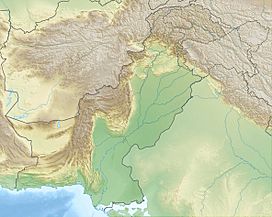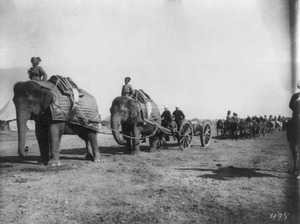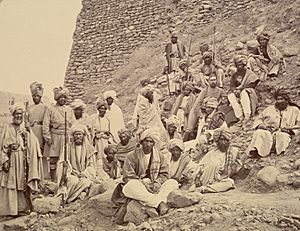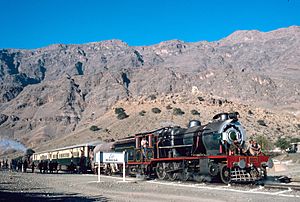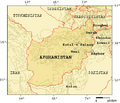Khyber Pass facts for kids
Quick facts for kids Khyber Pass |
|
|---|---|
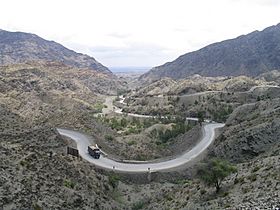
The pass connects Landi Kotal to the Valley of Peshawar.
|
|
| Elevation | 1,070 m (3,510 ft) |
| Traversed by | |
| Location | Between Landi Kotal and Jamrud |
| Range | Spīn Ghar (Safēd Kōh) |
| Coordinates | 34°04′33″N 71°12′14″E / 34.07570°N 71.20394°E |
The Khyber Pass is a famous mountain pass located in the northwest of Pakistan. It sits right on the border with Afghanistan. This important pass connects the town of Landi Kotal to the Valley of Peshawar at Jamrud. It does this by cutting through part of the Spin Ghar mountains.
For a very long time, the Khyber Pass has been a key part of the ancient Silk Road. This means it has always been super important for trade and culture between Eurasia (Europe and Asia). It was a vital trade route between Central Asia and South Asia. It was also a very important military spot for many different groups who wanted to control it. Today, the Khyber Pass is part of Asian Highway 1 (AH1).
Contents
History of the Khyber Pass
Many ancient groups, like the Indo-Aryans, may have moved into India through the Khyber Pass. Over time, many famous invaders used this pass. These included Cyrus the Great, Darius I of Persia, and Genghis Khan with his Mongol armies. Before the time of the Kushan Empire, the Khyber Pass was not used much for trade.
The Silk Road Connection
The Khyber Pass became a very important part of the Silk Road. This famous trade route stretched from Shanghai in the East all the way to Cadiz in Spain. Empires like the Parthian and Roman Empires fought to control passes like the Khyber. They wanted to get valuable goods like silk, jade, and rhubarb from China to Western Asia and Europe. Thanks to the Khyber Pass, Gandhara became a major trade center. It linked Bagram in Afghanistan to Taxila in Pakistan. This added Indian luxury goods like ivory, pepper, and textiles to the Silk Road trade.
Invaders and Local Control
Among the Muslim invaders of the Indian subcontinent, famous leaders like Mahmud of Ghazni and Muhammad of Ghor came through the Khyber Pass. Later, Sikh forces led by Ranjit Singh took control of the pass in 1834. However, they were defeated by Wazir Akbar Khan's forces in 1837. Hari Singh Nalwa, a Sikh general, was well-known in Afghanistan for guarding the pass for many years.
The areas around the Khyber Pass are home to different tribes. To the north is the Mullagori tribe. To the south is Afridi Tirah. The people living in the pass itself are Afridi clansmen. For centuries, these Pashtun tribes, especially the Afridis and the Afghan Shinwaris, have seen the pass as their own land. They often charged a fee to travelers for safe passage. This fee was a main source of income for them. Because of this, they strongly resisted anyone who challenged their control.
Modern Developments
After the First World War, the British built a special railway through the pass for strategic reasons. The Khyber Pass Railway opened in 1925. It ran from Jamrud, near Peshawar, to the Afghan border near Landi Kotal.
The pass became famous for many Westerners and Japanese travelers during the "hippie trail" days. They would travel by bus or car from Kabul to the Afghan border. At the Pakistani border, travelers were told to stay on the road. This area was a Federally Administered Tribal Area where control was not always strong. From the highway, you could see old forts and monuments left by British Army units.
The Khyber Pass area is also known for its local craft of making weapons. These are called "Khyber Pass copies" by gun collectors. Local blacksmiths use local steel and their forges to create these unique items.
The Khyber Pass Today
During the war in Afghanistan, the Khyber Pass was a very important route. It was used to send military supplies and food to NATO forces in Afghanistan. This started when the US began its actions in Afghanistan in 2001.
About 80 percent of the supplies for NATO and US forces traveled through the Khyber Pass by road. However, the situation in northwest Pakistan became less stable. This led the US and NATO to find other ways to deliver supplies.
The pass has also been used to move people from Afghanistan to Pakistan. Until late 2007, this route was fairly safe. The Pakistani government paid the local tribes to keep the area secure. But after that year, the Taliban started to control the region. This led to more problems and tensions in the area.
Images for kids
-
A camp of the British Indian Army near the Khyber Pass (c. 1920)
See also
 In Spanish: Paso Khyber para niños
In Spanish: Paso Khyber para niños


